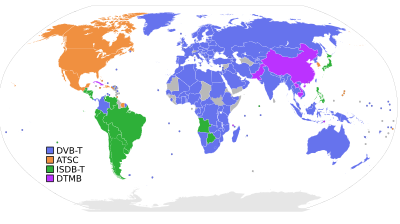
Terrestrial television or over-the-air television (OTA) is a type of television broadcasting in which the content is transmitted via radio waves from the terrestrial (Earth-based) transmitter of a TV station to a TV receiver having an antenna. The term terrestrial is more common in Europe and Latin America, while in Canada and the United States it is called over-the-air or simply broadcast. This type of TV broadcast is distinguished from newer technologies, such as satellite television, in which the signal is transmitted to the receiver from an overhead satellite; cable television, in which the signal is carried to the receiver through a cable; and Internet Protocol television, in which the signal is received over an Internet stream or on a network utilizing the Internet Protocol. Terrestrial television stations broadcast on television channels with frequencies between about 52 and 600 MHz in the VHF and UHF bands. Since radio waves in these bands travel by line of sight, reception is generally limited by the visual horizon to distances of 64–97 kilometres (40–60 mi), although under better conditions and with tropospheric ducting, signals can sometimes be received hundreds of kilometers distant.
Integrated Services Digital Broadcasting is a Japanese broadcasting standard for digital television (DTV) and digital radio.
Digital terrestrial television is a technology for terrestrial television where television stations broadcast television content in a digital format. DTTV is a major technological advance over analog television, and has largely replaced analog television broadcast, which had been in common use since the middle of the 20th century. Test broadcasts began in 1998 with the changeover to DTTV, also known as the Analog Switchoff (ASO) or Digital Switchover (DSO), which began in 2006 and is now complete in many countries. The advantages of digital terrestrial television are similar to those obtained by digitizing platforms such as cable TV, satellite, and telecommunications: more efficient use of radio spectrum bandwidth, provision of more television channels than analog, better quality images, and potentially lower operating costs for broadcasters.
ISDB-T International, also known in Brazil as Sistema Brasileiro de Televisão Digital, is a technical standard for digital television broadcast used in Brazil, Argentina, Peru, Botswana, Chile, Honduras, Venezuela, Ecuador, Costa Rica, Paraguay, Philippines, Bolivia, Nicaragua, El Salvador and Uruguay, based on the Japanese ISDB-T standard. ISDB-T International launched into commercial operation on 2 December 2007, in São Paulo, Brazil.

DWDB-TV is a television station in Metro Manila, Philippines, serving as the flagship of the GTV network. It is owned and operated by GMA Network, Inc. alongside GMA flagship DZBB-TV. Both stations share studios at the GMA Network Center, EDSA corner Timog Avenue, Diliman, Quezon City, while DWDB-TV's hybrid analog and digital transmitting facility is located at the GMA Tower of Power, Tandang Sora Avenue, Barangay Culiat, Quezon City.

DZBB-TV is a television station in Metro Manila, Philippines, serving as the flagship of the GMA network. It is owned and operated by the network's namesake corporate parent alongside GTV flagship DWDB-TV. Both stations share studios at the GMA Network Center, EDSA corner Timog Avenue, Diliman, Quezon City, while DZBB-TV's hybrid analog and digital transmitting facilities are located at the GMA Tower of Power, Tandang Sora Avenue, Barangay Culiat, Quezon City and Digital SFN towers located in Makati City, Manila, Antipolo City and Angeles City, Pampanga.

DZOE-TV is a television station in Metro Manila, Philippines, serving as the flagship of the A2Z network. It is owned by ZOE Broadcasting Network and operated by ABS-CBN Corporation under a blocktime agreement. The station maintains studios at the ABS-CBN Broadcasting Center, Sgt. Esguerra Ave. corner Mo. Ignacia St., Diliman, Quezon City and 22nd floor, Strata 2000 Bldg., Emerald Avenue, Ortigas Center, Pasig, while its hybrid analog and digital transmitting facility is located at Crestview Heights Subdivision, Brgy. San Roque, Antipolo, Rizal.

DWGT-TV is a television station in Metro Manila, Philippines, serving as the flagship of the government-owned People's Television Network. The station maintains studios and hybrid analog/digital transmitting facility at Broadcast Complex, Visayas Avenue, Brgy. Vasra, Diliman, Quezon City.

DWAQ-DTV was a television station in Metro Manila, Philippines, serving as the flagship of the religious channel SMNI. Owned and operated by Swara Sug Media Corporation, the station maintained studios at the ACQ Tower, Sta. Rita Street, Barangay Guadalupe Nuevo, Makati and a hybrid digital transmitting facility at KJC Compound, Barangay Sauyo, Novaliches, Quezon City.
DWKC-DTV is a television station in Metro Manila, Philippines, serving as the flagship of Broadcast Enterprises and Affiliated Media, Inc. Its main office is located at the 3rd floor, Globe Telecom Plaza 1, Pioneer St. cor. Madison St., Mandaluyong City, while its transmitter and master control is located at Palos Verdes Subdivision, Sumulong Highway, Brgy. Santa Cruz, Antipolo, Rizal.

ZOE Broadcasting Network, Inc. is a Philippine broadcast media arm of the Jesus Is Lord Church. Based in Ortigas Center, Pasig, it operates a network of television and radio stations in Mega Manila, Baguio, Bacolod, Cebu, Cagayan de Oro, Davao, Iloilo and Puerto Princesa. The company also owns its first television station in Metro Manila, DZOE-TV 11 and its DTT companion UHF channel 20, which currently airs the A2Z network, a joint-venture partnership between ZOE and ABS-CBN Corporation through its blocktime agreement.
DZOZ-DTV is a digital-only television station in Metro Manila, Philippines, serving as the flagship of the Light TV network. It is owned and operated by ZOE Broadcasting Network alongside A2Z flagship DZOE-TV, which is operated by ABS-CBN Corporation under a blocktime agreement. Both stations share studios at the 22nd floor, Strata 2000 Bldg., Emerald Avenue, Ortigas Center, Pasig, while DZOZ-DTV's transmitter is located at Crestview Heights Subdivision, Barangay San Roque, Antipolo, Rizal.
Television in the Philippines was introduced in October 1953 upon the first commercial broadcast made by Alto Broadcasting System, making the Philippines the first Southeast Asian country and the second in Asia to do so. Even before that, during the late 1940s, several academic experiments had been done and replicated by Filipino engineers and students.

Sonshine Media Network International (SMNI), also known by its name Swara Sug Media Corporation (SSMC), is a Filipino broadcast media arm of the Kingdom of Jesus Christ (KJC) led by the Filipino televangelist Apollo Quiboloy. Based in Davao City and Makati, it operates a network of radio and television broadcasting stations.

ABS-CBN TV Plus is a Philippine ISDB-T encrypted digital terrestrial television provider owned and operated by ABS-CBN Convergence, a subsidiary of ABS-CBN Corporation. The service distributes digital set-top boxes with freemium and free-to-view digital TV channels, Broadcast Markup Language, Emergency Warning Broadcast system, and pay per view services to selected areas in the Philippines. In order to avail the service, users must buy an ABS-CBN TVplus set-top box and activate it through ABS-CBNmobile SIM card; activation requirements for the digital channels through other mobile networks later became available around the second quarter of 2018.

Truth Channel is a Philippine religious television network. It is the flagship television network of the Members Church of God International (MCGI), together with UNTV News and Rescue, the network's carrier on free-to-air digital terrestrial television (DTT). It broadcasts 24 hours a day on Ultra High Frequency (UHF) Channel 38 (617.143 MHz) in Metro and Mega Manila, Rizal, Bulacan, Pampanga, Laguna, Cavite and some parts of Tarlac.

GMA Affordabox is a Philippine ISDB-Tb digital terrestrial television provider distributed and marketed by GMA New Media, a subsidiary of GMA Network. The service distributes digital set-top boxes and USB OTG dongles with free-to-air digital TV channels, broadcast markup language, emergency warning broadcast system, functional auto-on alert, digital display, and info display services to select areas in the Philippines.

A2Z is a Philippine free-to-air blocktime broadcast television network based in Quezon City, with its studios located in Ortigas Center, Pasig. It serves as a flagship property of ZOE Broadcasting Network in partnership with ABS-CBN Corporation as its main content provider through a blocktime agreement. A2Z's flagship television station is DZOE-TV which operates on channel 11, and channel 20. The network's name is an abbreviation derived from the first letter of the names of two parent companies, ABS-CBN and ZOE, and the channel number of the now-recalled frequency of the former network.

Sulit TV is a Philippine ISDB-Tb digital terrestrial television provider owned and operated by TV5 Network, Inc. The service distributes digital set-top boxes with free-to-air digital TV channels, multimedia player, video recorder, broadcast markup language, and emergency warning broadcast system features available in select areas in the Philippines. Sulit TV launched on September 10, 2021.












